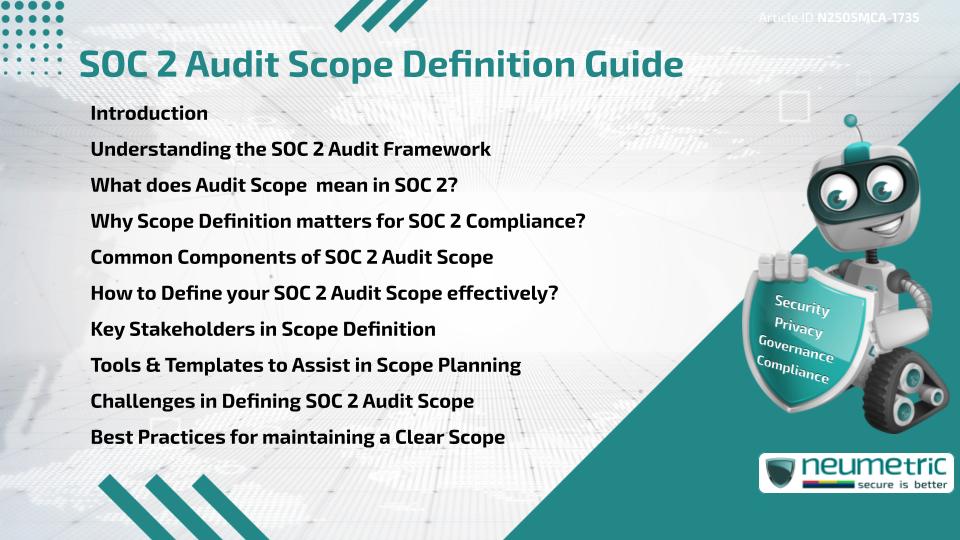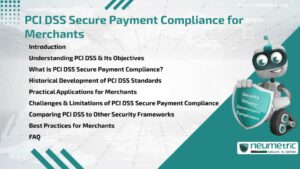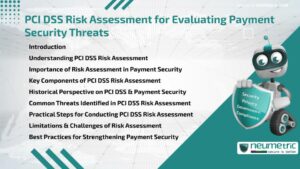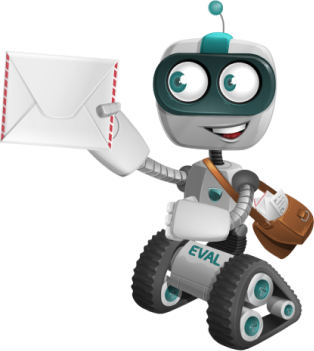Table of Contents
ToggleSOC 2 Audit Scope Definition Guide
Introduction
Defining the Audit Scope is one of the most critical steps when preparing for a System & Organisation Controls 2 [SOC 2] Audit. Without a clear boundary of what Systems, Processes & Controls are included, the Audit may miss key Risks or become unnecessarily complex. This SOC 2 Audit Scope definition guide helps Businesses, especially Startups & SaaS Providers, navigate the process of outlining the scope clearly, effectively & in alignment with Audit goals.
Whether you are aiming for a Type I or Type II Audit, this guide walks through Key Components, Tools & Best Practices for successful Scope Definition.
Understanding the SOC 2 Audit Framework
SOC 2 Audits are conducted based on the Trust Services Criteria defined by the American Institute of Certified Public Accountants [AICPA]. These include:
- Security
- Availability
- Processing Integrity
- Confidentiality
- Privacy
The Audit assesses how an Organisation meets these criteria through Internal Controls & Operational Policies. The SOC 2 Audit Scope definition guide ensures that only relevant areas & systems are included to demonstrate Compliance.
What does Audit Scope mean in SOC 2?
Audit scope refers to the boundaries & limits of the Audit. In a SOC 2 context, it answers questions such as:
- Which Systems & Services are being audited?
- What Physical or Cloud Infrastructure supports them?
- Which Trust Services Criteria are applicable?
- Who are the Customers & Users affected?
The SOC 2 Audit Scope definition guide focuses on eliminating ambiguity & ensuring clarity so the Audit process stays efficient & focused.
Why Scope Definition matters for SOC 2 Compliance?
Without a defined Scope, Organisations Risk overspending time & Resources or Failing to include critical components. Some practical benefits of clear scope definition include:
- Reduced Audit Fatigue: Focus only on Systems that truly matter.
- Stronger Evidence Collection: Audit teams know exactly what to evaluate.
- Risk-Based prioritisation: High-Risk Services get appropriate control coverage.
According to the Cloud Security Alliance, defining scope also improves communication across Internal Stakeholders & Auditors.
Common Components of SOC 2 Audit Scope
The SOC 2 Audit Scope definition guide typically includes the following components:
- In-Scope Systems: Applications, Platforms or APIs offered to Customers.
- Supporting Infrastructure: Servers, Cloud Providers or Databases.
- Personnel: Roles with Access or Control over Systems in scope.
- Policies & Procedures: Documentation that governs Data Protection.
- Third Parties: Vendors or Partners impacting Service Delivery.
If a SaaS Platform hosts User Data, for example, then its Database Layer, Access Management Policies & Monitoring Tools all fall within Scope.
How to Define your SOC 2 Audit Scope effectively?
Follow these steps from the SOC 2 Audit Scope definition guide to define your scope:
- Inventory Systems & Services: List all Customer-facing Features.
- Map Data Flows: Identify where data originates, moves & is stored.
- Apply Trust Services Criteria: Choose relevant criteria like Security or Privacy.
- Identify Users & Access Points: Who interacts with these Systems?
- Exclude Out-of-Scope Elements: Justify what is not included.
Key Stakeholders in Scope Definition
Several teams need to be involved in defining the SOC 2 scope, such as:
- Engineering: Understands System Architecture.
- DevOps/IT: Maps Infrastructure & Access Control.
- Legal & Compliance: Identifies Regulatory Risks.
- Product & Customer Success: Understands Service Obligations.
The SOC 2 Audit Scope definition guide recommends assigning ownership to each Stakeholder so scope-related responsibilities are clear.
Tools & Templates to Assist in Scope Planning
Many Companies use Checklists & Tools to support this process. Some helpful resources include:
- AICPA’s SOC 2 Guide
- CIS Controls
- Spreadsheets mapping Trust Services Criteria to Internal Controls
- System Diagrams & Access Control matrices
- Readiness Assessment Platforms
These assist with structuring documentation for consistent Evidence Collection.
Challenges in Defining SOC 2 Audit Scope
The SOC 2 Audit Scope definition guide also highlights common obstacles:
- Over-Scoping: Including too many systems leads to inefficiency.
- Under-Scoping: Missing key assets can invalidate the Audit.
- Inconsistent Understanding: Different departments interpret scope differently.
- Changing Environments: Cloud-native setups evolve quickly.
To manage these Risks, align scope reviews with Sprint Cycles or Quarterly Audits.
Best Practices for maintaining a Clear Scope
To ensure long-term Audit readiness, follow these Best Practices:
- Review scope regularly with Compliance & IT Teams.
- Document reasons for Inclusion or Exclusion of Systems.
- Train Employees on Scope Boundaries & Roles.
- Maintain Version Control for scope documentation.
- Use Diagrams or Visuals to support Auditor understanding.
A SOC 2 Audit Scope definition guide is not a one-time exercise—it is an ongoing process that evolves with your Business.
Takeaways
- The SOC 2 Audit Scope definition guide helps prevent wasted effort or Audit failure.
- Clearly defined scope supports Evidence Collection & efficient Control Testing.
- Stakeholders from multiple departments should collaborate on Scope Planning.
- Tools like Templates, Diagrams & Frameworks make the process easier.
- Regular review & documentation are key to long-term SOC 2 readiness.
FAQ
What is the first step in a SOC 2 Audit Scope definition guide?
Start by identifying all Systems & Services that interact with Customer Data.
Why is Audit Scope important in SOC 2?
It limits the focus of the Audit, ensures critical areas are covered & avoids wasted effort.
Can Audit Scope change mid-way through a SOC 2 Project?
Yes, but changes should be documented clearly & communicated to the Auditor.
How is Cloud Infrastructure handled in SOC 2 Audit Scope?
Cloud Platforms must be included if they support in-scope Systems or store Sensitive Data.
What are common mistakes in defining SOC 2 Audit Scope?
Over-Scoping, Under-Scoping & Failing to involve the right Stakeholders.
Are Third Party Vendors included in the scope?
Yes, if they impact Service Delivery or Data Security, they should be in scope.
What criteria help define Audit scope relevance?
Trust Services Criteria, System Architecture, Data Sensitivity & User Access all matter.
Who defines the SOC 2 Audit Scope in a Company?
Scope is defined collaboratively by Engineering, IT, Legal & Compliance Teams.
Need help?
Neumetric provides organisations the necessary help to achieve their Cybersecurity, Compliance, Governance, Privacy, Certifications & Pentesting goals.
Organisations & Businesses, specifically those which provide SaaS & AI Solutions, usually need a Cybersecurity Partner for meeting & maintaining the ongoing Security & Privacy needs & requirements of their Clients & Customers.
SOC 2, ISO 27001, ISO 42001, NIST, HIPAA, HECVAT, EU GDPR are some of the Frameworks that are served by Fusion – a centralised, automated, AI-enabled SaaS Solution created & managed by Neumetric.
Reach out to us!





